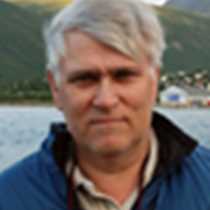Barents Sea
Today we approached an island named Björnöya, located between Svalbard and mainland Norway, with high hopes for an amazing Zodiac cruise ahead. This is an expedition and three words stand out while traveling in the Polar Regions: flexibility, flexibility and flexibility. Over the days, Svalbard has repeatedly confirmed this on several occasions; you can make plans but most likely nature will force you to change them many times. Yesterday the polar bears forced us to change and today: wind and swell. Forces of nature decide many times what we can achieve, and this was one of these days. A gusting wind from the south with big swells and fog made it almost impossible to see the island. Conditions for any zodiac operations were out of the question.
Björnöya (Bear Island) is one of few islands located in the shallow Barents Sea, just on the border to the much deeper ocean to the west. In fact the shallow Barents Sea is on the continental shelf and a major “hot spot” for future gas and oil ventures. Here the North Atlantic Drift (Gulf Stream) brings warm water from the far south, still heading north, meets a cold water current coming from the east, the Siberian Current. Conditions for a major clash are ideal, cold meeting warm. The island is often embedded in fog, which usually will not force us to leave out this spectacular stop but today there was an added wind from the south and huge swells. For all other wind directions the island itself can bring some shelter and make an operation possible, except if it is from the south.
Being one of the few islands in the Barents Sea having high cliff faces, which for those brave enough to get outside we saw a large number of seabirds very briefly as the captain took us as close as possible during current conditions. Björnöya is a major breeding site for a number of different seabird species. The Barents Sea, having two major ocean currents bringing nutrition and also through the summer 24 hours of daylight is one of the most productive ocean areas in the world. Millions of seabirds feed and breed here and thousands of whales use this major resource every summer.
As the planned morning activity was canceled, our expedition leader, Bud Lehnhausen, formulated a new plan. The captain set the bow for northern Norway and hopefully tomorrow we can make a Zodiac cruise along some of the bird cliffs along the coast of Norway.
As the seas conditions throughout the morning was rather rough many spent time in their cabins enjoying a good sleep or watching the presentations given. In the afternoon the sea conditions rapidly improved and for tea time it was a long line with hungry faces.
For the evening recap some staff performed with great joy a newly-written song about polar bears. Although we never got to see or land at Björnöya, at least those who made it for dinner got a taste of the island: crew-caught cod from the area from an earlier visit this season.
Soon in sheltered Norwegian fjords and something new to look forward to!




